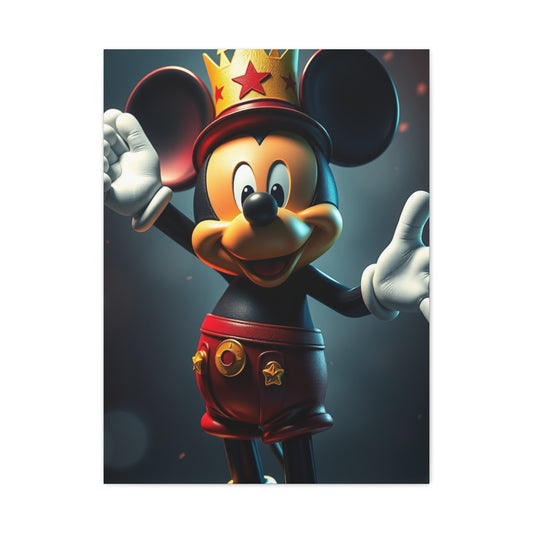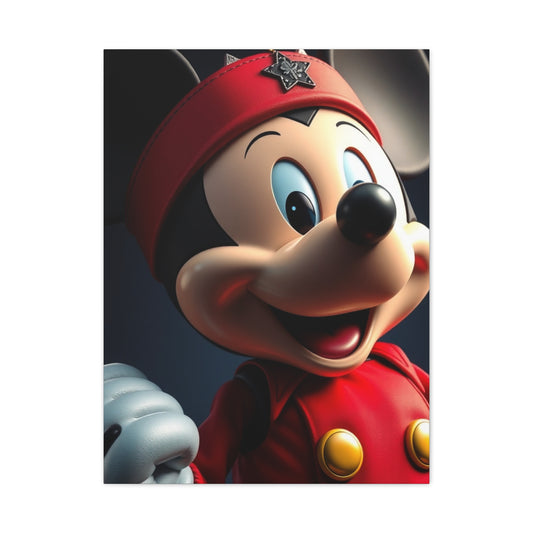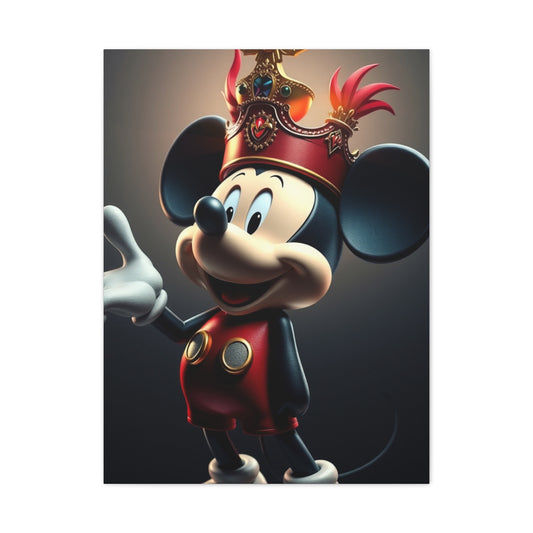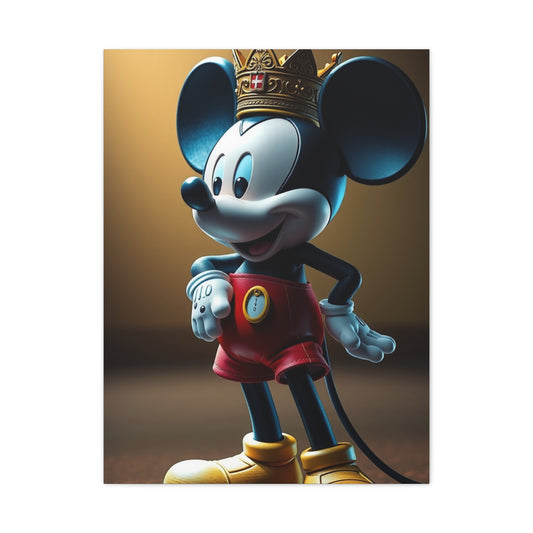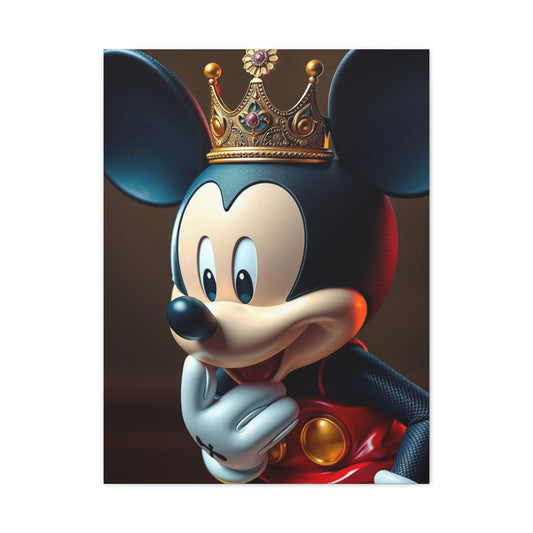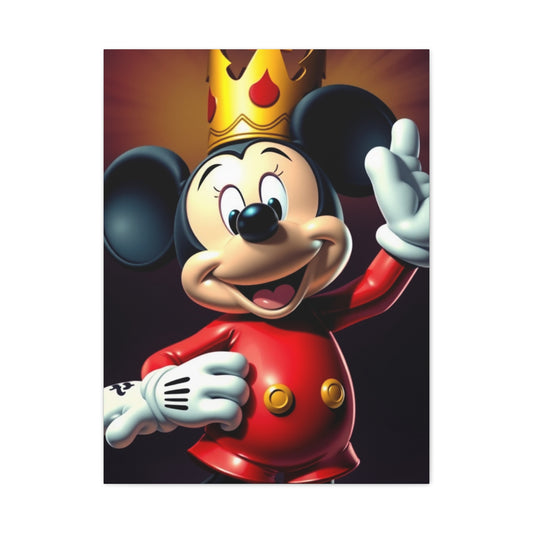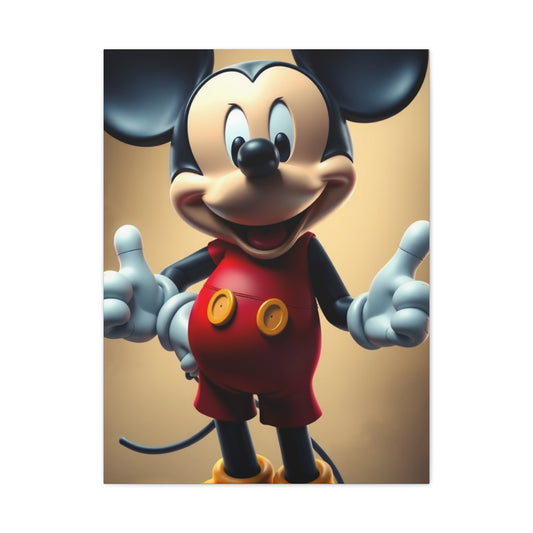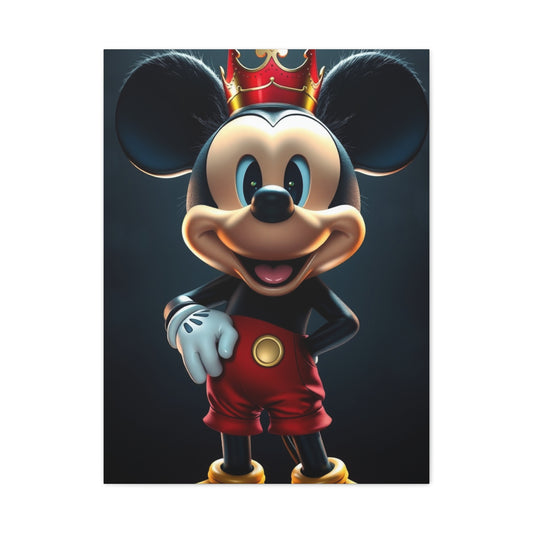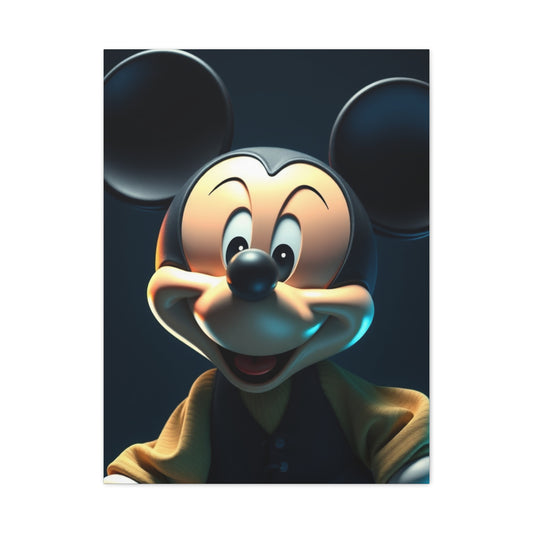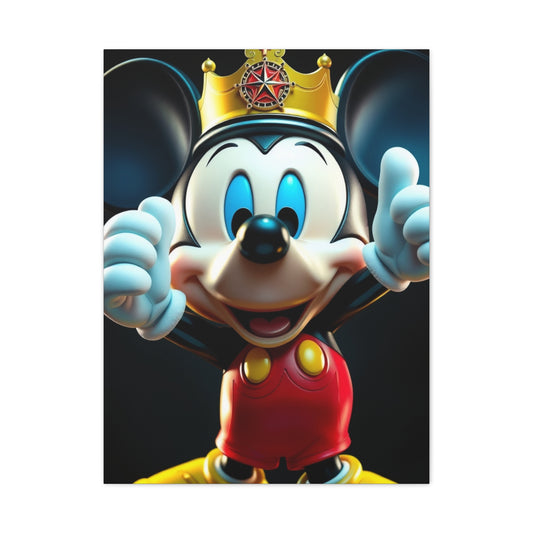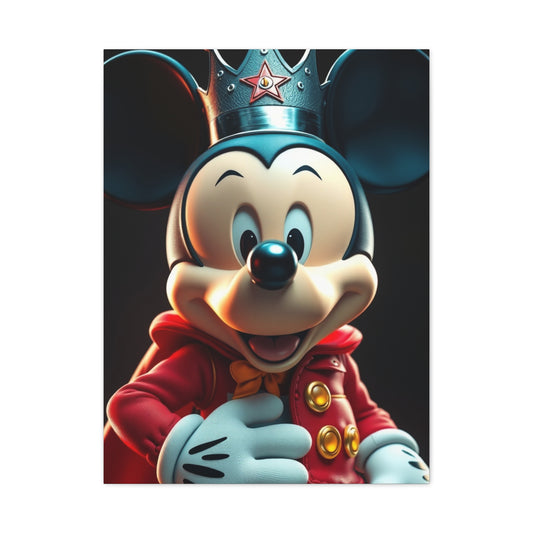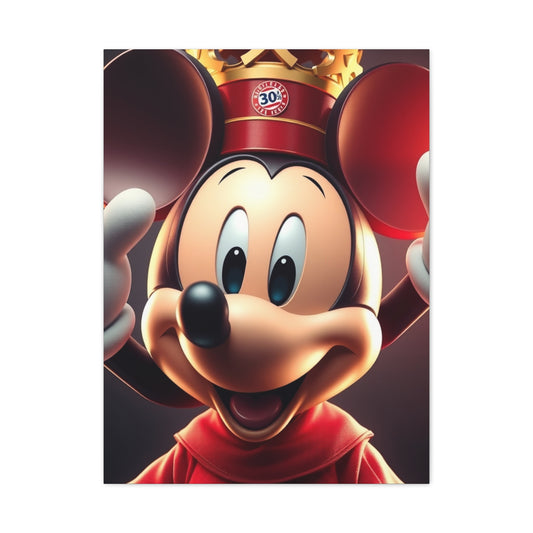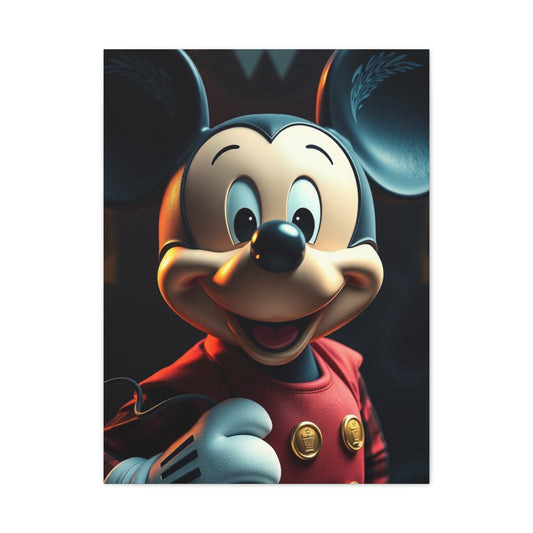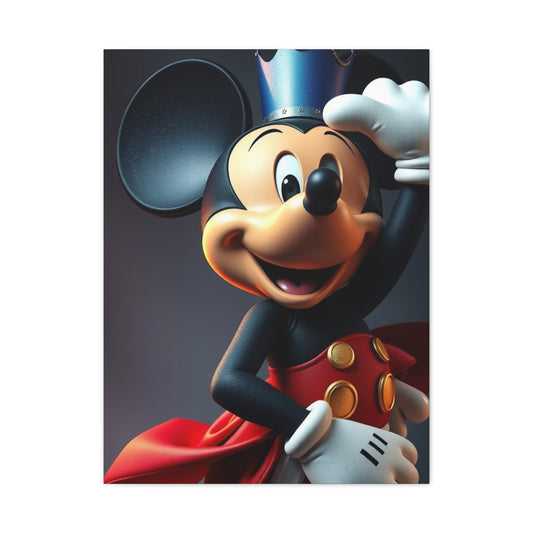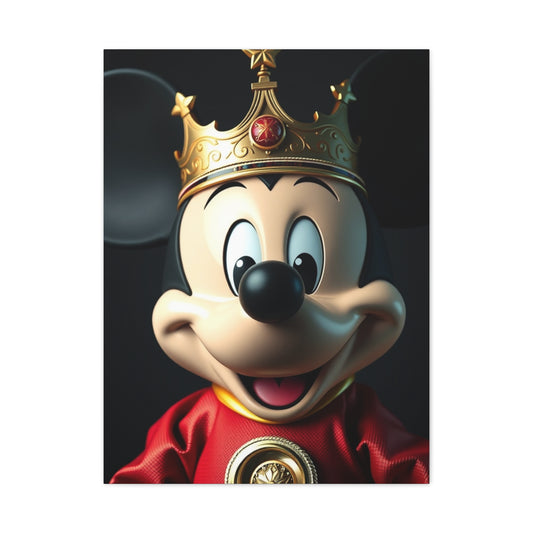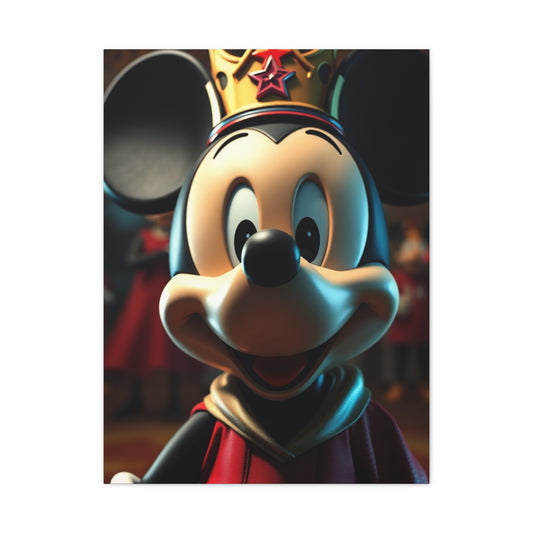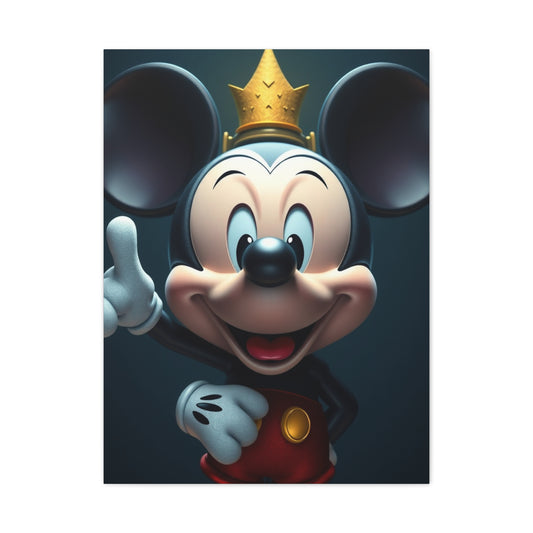Creative Mouse Wall Art Ideas for Playful Interiors
Decorating one’s walls is far more than just filling up empty spaces; it is about curating a personal atmosphere that mirrors character, nostalgia, and taste. Mouse wall art is a perfect embodiment of this notion because it weaves whimsy and imagination into ordinary interiors. With their playful silhouettes, expressive personalities, and storytelling appeal, depictions of mice can bring both sophistication and humor into rooms. Unlike generic patterns or abstract motifs that often blend into the background, mouse wall art has the capacity to capture attention, spark conversation, and create an emotional connection.
This genre of decoration balances charm with creativity, making it versatile for both contemporary homes and traditional spaces. A child’s nursery may benefit from the cheerfulness of a mischievous mouse illustration, while a modern office can feel uplifted by the sleek minimalism of a mouse line drawing. Regardless of placement, the artwork turns mundane walls into portals of delight, offering more than mere ornamentation.
To fully appreciate the uniqueness of mouse wall art, it is worth delving into its origins, its foundational ideas, its multiple variations, and the ways it can be thoughtfully integrated into a living space.
Historical Background
Although it may seem like a modern decorative innovation, mouse imagery in art has deep cultural and historical roots. Ancient civilizations often attributed symbolic meanings to animals, and the mouse was no exception. In Egyptian mythology, mice were considered creatures of agility and survival, often representing adaptability. Early Greek stories saw them as messengers of resourcefulness, capable of thriving in small spaces where other beings could not.
During the Middle Ages, mice appeared in manuscripts and folk illustrations. They were depicted both as tricksters and as endearing little companions, embodying the duality of mischief and innocence. Artisans from this era often placed mouse motifs in the margins of illuminated texts, signaling humor or satire. By the Renaissance, artists began incorporating animals, including mice, into allegorical paintings, where their presence suggested cleverness, vigilance, or caution.
In later centuries, particularly during the Victorian period, the popularity of animal illustration in children’s literature surged. Mice became beloved characters in picture books, fairy tales, and household objects. They symbolized both fragility and bravery, often embodying underdog heroes who triumphed through wit and perseverance. These literary depictions influenced visual art trends, inspiring illustrations, prints, and eventually decorative wall pieces that carried forward this tradition.
As the twentieth century unfolded, the mouse gained an even stronger foothold in popular culture. From animated characters to illustrated storybooks, its persona grew into a universal icon of charm and lightheartedness. This cultural embrace paved the way for the current wave of mouse wall art, where playful charm intersects with modern artistic sensibilities.
Core Concepts and Foundations
At the heart of mouse wall art lies the blending of narrative and design. The central concept is not simply to replicate the appearance of a mouse but to capture its spirit—be it mischievous, nurturing, curious, or adventurous. This foundational approach makes the artwork engaging rather than superficial.
One of the key ideas behind this decor is whimsy. Mice, being small and often overlooked, are naturally associated with wonder when elevated into a focal artistic element. Their miniature scale allows for imaginative compositions: a mouse balancing on a balloon, reading a book, or peeking out from behind a door. These playful scenarios transform the ordinary into magical moments, a quality that resonates strongly in art intended for home spaces.
Another foundational aspect is versatility. Mouse wall art can range from realistic sketches to abstract interpretations, from vintage illustrations to bold contemporary graphics. This adaptability means it can fit into rustic cottages, sleek urban apartments, or eclectic studios with equal ease. The essence lies not in the style but in the ability to evoke emotion and intrigue.
Finally, a philosophical underpinning of mouse wall art is storytelling. Unlike purely decorative motifs, these artworks often carry an implicit narrative—whether that story is of adventure, nostalgia, or humor. By inviting viewers to imagine or recall a scene, they turn walls into more than surfaces; they become canvases of lived or imagined experiences.
Types and Categories
Mouse wall art is remarkably diverse, encompassing a spectrum of styles, mediums, and interpretations. This diversity ensures that there is something for everyone, no matter the interior design preference.
One major category is illustrative mouse art, often inspired by children’s books and folklore. These works use detailed line drawings, pastel shades, and narrative elements, making them ideal for nurseries, libraries, or creative corners. Illustrations often depict mice engaging in human-like activities such as playing instruments, reading, or sipping tea, creating a charming and relatable scene.
Another category is vintage mouse wall art, which draws inspiration from antique prints and historical drawings. These artworks frequently use sepia tones or botanical backdrops, offering a timeless elegance. Vintage mouse prints complement spaces with rustic furniture, cottage-style decor, or retro collections, adding both nostalgia and refinement.
Minimalist mouse art is a modern interpretation where the focus is on clean lines and subtle elegance. Using simple strokes or monochromatic palettes, these artworks can integrate seamlessly into Scandinavian-inspired or contemporary spaces. A single continuous line forming the silhouette of a mouse demonstrates how simplicity can be powerful in creating visual impact.
On the more elaborate side is whimsical mouse art, bursting with color, imagination, and storytelling. These pieces often feature mice in fantastical or humorous scenarios—riding bicycles, wearing crowns, or exploring enchanted landscapes. Such artwork is especially popular in children’s playrooms, though it can also enliven adult living rooms that embrace eclectic or artistic decor.
Beyond prints and canvases, sculptural and mixed-media mouse wall art has grown in popularity. Crafted from wood, metal, or ceramics, these three-dimensional pieces introduce texture and depth to walls, turning flat surfaces into dynamic focal points. Their tactile quality makes them stand out, especially in spaces where visual interest is essential.
In recent years, digital and pop art interpretations have emerged, incorporating bold colors, geometric patterns, and modern aesthetics. These works appeal to younger audiences or those who enjoy urban-inspired decor, blending cultural relevance with playful motifs.
Practical Applications
Understanding the beauty of mouse wall art goes beyond admiration; it also involves knowing how to apply it effectively within different spaces. Placement, combination, and thematic alignment all play crucial roles in ensuring that the artwork enhances rather than overwhelms a room.
In children’s rooms, mouse wall art can serve as both decor and inspiration. Illustrated or whimsical pieces encourage creativity, storytelling, and joy, making them more than mere ornaments. They can be arranged above a reading nook, near a play corner, or as part of a gallery wall that nurtures a child’s imagination.
Living rooms benefit from more refined mouse artwork, such as vintage illustrations or minimalist line drawings. These designs maintain sophistication while adding a subtle dash of charm. Positioning them above sofas, sideboards, or near fireplaces ensures they catch the eye without clashing with other elements of decor.
For workspaces or home offices, mouse art can provide a refreshing break from rigidity. A cleverly designed mouse illustration can soften the seriousness of a desk area, bringing warmth to what might otherwise feel sterile. It helps stimulate creativity while fostering a sense of comfort.
In less obvious places, such as hallways, kitchens, or laundry areas, mouse wall art can turn transitional or mundane zones into cheerful spots. A hallway lined with small mouse prints adds narrative flow to a space that is often overlooked, while a kitchen corner adorned with whimsical mouse art creates a sense of homeliness and humor.
Additionally, mouse wall art can be seasonal or thematic. For festive occasions, playful prints with holiday motifs bring seasonal joy, while year-round themes like nature or fantasy keep walls vibrant throughout the year. The adaptability of mouse art ensures it can always find a purpose in any decorative scheme.
Techniques and Methods
Mouse wall art is created through a fascinating variety of artistic techniques, each shaping how the final piece feels within a space. Understanding these methods allows both collectors and decorators to appreciate the craftsmanship while also choosing works that align with their aesthetic vision.
One of the most beloved approaches is watercolor painting. This medium lends a softness and fluidity that captures the gentle nature of mice. Artists often use translucent washes and delicate brushwork to highlight their whimsical features, resulting in artwork that feels airy and enchanting. Watercolor mouse scenes are frequently found in nurseries and reading corners, as the dreamy qualities of this technique align with storytelling and comfort.
Another common method is ink illustration. With precise lines and detailed shading, ink allows for crisp depictions of small details like whiskers, fur, and tiny paws. This technique is especially popular for vintage-inspired mouse wall art, evoking illustrations from classic literature and botanical prints. Ink drawings pair beautifully with sepia tones or muted backdrops, making them versatile for both traditional and eclectic interiors.
For a more modern appeal, digital art has risen in popularity. Artists can manipulate bold colors, layered textures, and surreal effects to create images in imaginative contexts. Digital methods also allow for reproducibility, making high-quality prints accessible at various price ranges. These pieces often carry a contemporary edge, appealing to younger audiences or those with minimalistic, graphic-driven tastes.
Sculptural and mixed-media techniques add dimension to mouse wall art. Crafted from wood, metal, ceramic, or recycled materials, these works transform walls into interactive surfaces. A bronze mouse head mount, for instance, can introduce an unexpected focal point, while hand-carved wooden mice bring warmth and craftsmanship. The tactile quality of mixed media makes the art not only visual but experiential, creating intrigue in any room.
Minimalist line art has also become a favored method, where a single uninterrupted stroke forms the outline of a mouse. This approach strips away excess detail, leaving behind the essence of form. Its elegance lies in its restraint, allowing it to adapt to diverse settings without overwhelming the space.
Beyond the materials and media, framing and presentation techniques influence how the mouse wall art is perceived. Rustic wooden frames can enhance vintage or pastoral themes, while sleek metallic frames emphasize modernism. Some pieces are left unframed for a raw, casual effect, while others are mounted on canvas for gallery-style presence. Collectors often experiment with arrangement techniques, from singular statement displays to multi-piece galleries, each method altering the rhythm of how the art interacts with its surroundings.
Challenges and Common Mistakes
As delightful as mouse wall art can be, selecting, creating, or displaying it is not without challenges. Many enthusiasts fall into pitfalls that undermine the potential impact of their chosen artwork.
One frequent mistake is choosing the wrong scale. A tiny print placed on a large, bare wall often appears lost, while an oversized canvas can overwhelm a compact space. Balancing proportions is critical, and failing to measure beforehand can lead to mismatched visuals that disrupt harmony rather than enhance it.
Another common error is neglecting context. While mouse wall art is inherently playful, not every style suits every environment. A whimsical cartoonish mouse might look out of place in a minimalist office, just as a stark abstract design might feel too austere in a child’s room. Overlooking the relationship between the art’s tone and the surrounding decor often results in visual discord.
Color clashes also present challenges. A bright mouse illustration may not sit well in a room dominated by muted earth tones, while subdued sepia prints may fade into invisibility against a vibrantly painted wall. Many buyers choose art based solely on personal preference without considering how its palette interacts with the existing environment.
For collectors, another challenge lies in authenticity. With the rise of mass-produced prints, it is easy to acquire generic pieces that lack the originality of handmade or artist-signed works. While these reproductions can still be charming, they sometimes diminish the uniqueness that mouse wall art is celebrated for. A discerning eye is needed to differentiate between generic decor and authentic artistry that carries personal and cultural resonance.
Care and preservation also present hurdles. Mouse wall art created with delicate mediums such as watercolor or paper prints can be vulnerable to fading, humidity, or accidental damage. Many owners neglect proper framing, protective glass, or mindful placement, leading to deterioration over time. Improper cleaning methods—such as using harsh sprays directly on framed art—can also harm the integrity of the piece.
On the creative side, artists sometimes fall into repetitive patterns, producing overly literal depictions of mice without exploring symbolic or imaginative potential. While a realistic mouse sketch has its charm, failing to innovate can reduce the artwork to mere decoration rather than an expressive narrative. Overemphasis on cuteness, without balance or depth, can also limit appeal to broader audiences who seek artistry beyond surface-level charm.
Recognizing these challenges allows both collectors and creators to make more intentional decisions, ensuring that mouse wall art fulfills its potential as a meaningful and enduring decorative choice.
Trends and Future Outlook
As interior design evolves, so too does the demand for specific artistic expressions. Mouse wall art, once confined largely to children’s spaces or niche collectors, has grown into a vibrant genre with global appeal. Observing current trends offers insight into where this art form is headed in the future.
One prominent trend is nostalgia-driven design. Many homeowners are turning to vintage-style mouse illustrations reminiscent of mid-century children’s books and folk art. These pieces tap into collective memory, evoking simpler times and cozy atmospheres. Such nostalgia is particularly attractive in an era where digital speed dominates, offering a comforting return to hand-drawn intimacy.
Sustainability is also reshaping artistic practices. Eco-conscious artists are increasingly using recycled paper, organic inks, or repurposed wood to create mouse wall art that aligns with environmental values. This trend not only supports ecological awareness but also gives buyers the satisfaction of owning pieces that merge beauty with responsibility. Future directions are likely to see further innovation in biodegradable materials and carbon-neutral production methods.
Personalization is gaining momentum as well. Instead of purchasing generic prints, many collectors now commission customized mouse artworks that reflect personal narratives—such as a mouse character modeled after a family pet or an illustration tied to a memorable story. Technology is making this trend more accessible, with digital platforms allowing direct collaboration between artists and buyers.
Another significant direction is the blending of fantasy and realism. Contemporary mouse art increasingly depicts these creatures in surreal landscapes, sometimes integrating them with symbolic motifs like moons, books, or enchanted gardens. This imaginative blending appeals to audiences who desire artwork that is not only decorative but also thought-provoking.
Interactive and augmented reality art is beginning to influence wall decor. Mouse wall art may one day be paired with digital applications, allowing viewers to use a device to bring the mouse characters to life through animation. This merging of physical and digital art suggests an exciting frontier, expanding the immersive quality of home decor.
Looking ahead, the future of mouse wall art seems expansive. As cultural appreciation for animal symbolism continues to grow, and as design shifts toward personal storytelling, these whimsical creations will likely find an enduring role in both domestic and public spaces. Whether through sustainability, customization, or technological integration, mouse wall art is poised to remain relevant and evolve with the changing landscape of interior design.
Expert Insights
Artists, designers, and collectors who work closely with mouse wall art often emphasize its unique qualities and potential. Their perspectives shed light on why this genre has captured hearts across generations and how it can continue to flourish.
Many artists describe mouse imagery as inherently relatable. Unlike more majestic animals such as lions or eagles, mice represent humility, adaptability, and resourcefulness. This relatability makes them ideal subjects for storytelling. As one illustrator explained, drawing a mouse in everyday activities is a way of holding up a mirror to human life, offering humor and empathy without grandeur.
Interior designers often note the versatility of mouse wall art in blending with diverse decor styles. A minimalist designer might recommend a sleek line drawing for its ability to complement uncluttered spaces, while a bohemian designer might lean toward colorful, whimsical scenes that enhance eclectic layers. They emphasize that mouse art is not confined to children’s rooms but can elevate living rooms, kitchens, or even professional settings with unexpected charm.
Collectors highlight the emotional resonance of these artworks. Unlike abstract pieces that may feel distant, mouse art often triggers nostalgia or delight, creating an immediate connection. Several collectors share that their favorite mouse artworks remind them of beloved childhood stories or personal memories, making the pieces not just decor but cherished keepsakes.
Art historians draw attention to the enduring symbolic significance of mice in cultural narratives. They point out that across folklore traditions, mice often serve as underdog figures who triumph through wit, embodying resilience and cleverness. This symbolism resonates strongly in contemporary times, where themes of perseverance and imagination continue to inspire.
From a market perspective, experts predict that the demand for mouse wall art will expand as buyers seek more personalized and meaningful decor. Unlike mass-produced abstract prints, mouse artworks offer storytelling value, making them ideal for spaces that strive for individuality. With online platforms connecting global audiences to independent artists, the genre is experiencing a renaissance of accessibility and creativity.
In summary, expert voices converge on one idea: mouse wall art thrives because it is more than decoration. It is narrative, nostalgia, and symbolism rolled into one, adaptable to any home or setting. Whether through refined vintage prints, playful digital illustrations, or eco-conscious mixed-media creations, the genre continues to enchant and evolve, ensuring that it remains a staple in both contemporary and timeless decor.
Emerging Trends in Wall Art
The world of wall decor has always reflected cultural shifts, design movements, and evolving tastes, and mouse wall art is no exception. As contemporary interiors grow more experimental and expressive, mouse imagery has found new avenues of innovation that stretch far beyond the traditional motifs of whimsy or childhood nostalgia. Exploring these emerging trends not only illuminates the artistic possibilities but also demonstrates why this genre continues to capture attention across different audiences.
One of the strongest trends is the revival of folkloric aesthetics. Artists are reimagining traditional tales and myths where mice play central roles, from European fables to Asian folklore, infusing them with modern techniques and palettes. These works often combine muted backgrounds with intricate linework, creating a fusion of antiquity and freshness. They appeal to those who desire storytelling in their living spaces, bridging cultural memory with present-day artistry.
Another direction is the rise of minimalist elegance. Rather than intricate detail, artists are focusing on clean silhouettes and monochromatic tones to represent mice. This trend aligns with the larger minimalist movement in interior design, where homeowners prefer subtle imagery that harmonizes with uncluttered surroundings. The simplicity of a single continuous line forming the shape of a mouse can bring sophistication without overwhelming the room.
Sustainability-driven creativity is also reshaping how mouse wall art is made. Artists are increasingly sourcing recycled paper, reclaimed wood, and eco-friendly pigments. Beyond the physical materials, the concept of sustainability extends to the messages within the art. Many works emphasize harmony between animals and human environments, symbolizing coexistence and environmental mindfulness. As eco-consciousness continues to define consumer choices, such artwork resonates as both decoration and advocacy.
A growing fascination with surrealism is steering mouse imagery into dreamlike territories. These pieces often depict mice within enchanted landscapes, interacting with oversized objects, celestial skies, or abstract geometries. The juxtaposition of scale and context invites viewers to enter imaginative worlds, breaking the boundary between reality and fantasy. Such surrealistic works appeal to those who crave conversation pieces that stretch beyond the ordinary.
Cultural fusion is another emerging hallmark. Global connectivity allows artists to draw inspiration from diverse traditions. A mouse rendered in Japanese sumi-e brushwork carries the spirit of Zen minimalism, while a vibrant Mexican folk-art rendition bursts with saturated hues and geometric patterns. This cross-pollination of techniques enriches the genre, allowing collectors to embrace global artistry within the intimacy of their walls.
Technology-driven innovation is also transforming the landscape. Digital platforms enable layered textures, glowing effects, and interactive qualities. Some artists are experimenting with augmented reality, where scanning a mouse artwork with a device reveals animations or hidden stories. Such hybrid creations blur the lines between static art and dynamic experience, engaging younger audiences who seek immersion and novelty.
Personalization continues to gain traction. Buyers increasingly commission custom mouse portraits reflecting personal experiences, hobbies, or symbolic meanings. A family might request a painting of mice gathered around a book to signify their love of reading, while another might prefer an adventurous mouse exploring a landscape reminiscent of a cherished travel destination. This trend underscores a broader cultural movement toward individuality in home decor.
Emerging trends also include gallery-style curation within homes. Instead of single pieces, collectors are creating thematic clusters of mouse artworks, arranged in grids or organic clusters. This approach transforms a wall into a narrative gallery, each piece contributing to a broader storyline. The curation itself becomes an act of art, allowing homeowners to design walls that feel immersive and layered.
In essence, the trends shaping mouse wall art mirror broader shifts in contemporary aesthetics: nostalgia blended with modernism, sustainability coupled with creativity, and technology harmonized with tradition. These movements ensure that this genre remains fresh and adaptable, ready to evolve with the changing sensibilities of interior design enthusiasts.
Step-by-Step Guides
For those seeking to incorporate mouse wall art into their living spaces, the process can be both exciting and overwhelming. A structured approach ensures that the outcome feels cohesive, personal, and harmonious. Below are step-by-step insights to help navigate the journey from inspiration to installation.
Step 1: Defining Purpose and Mood
Before choosing or creating any piece, it is essential to define the role the art will play within the space. Ask yourself whether you want the mouse imagery to evoke playfulness, elegance, nostalgia, or surreal wonder. A nursery might call for gentle watercolor illustrations, while a contemporary office could benefit from sleek monochrome prints. Clarifying purpose establishes a foundation that guides every subsequent decision.
Step 2: Exploring Styles and Techniques
Once the mood is set, explore the diverse techniques available. Watercolor provides softness, ink offers precision, digital art delivers modern vibrancy, and mixed media adds texture. Consider how each method interacts with your space. For instance, a rustic room may pair beautifully with hand-carved wooden mouse wall art, while a modern loft might shine with bold digital abstracts. Sampling different styles through online galleries or local exhibitions can spark inspiration.
Step 3: Considering Color Harmony
Color is one of the most powerful elements in wall decor. Select a palette that either complements or contrasts your existing interiors. Soft neutral mouse illustrations blend seamlessly into serene environments, while bright, saturated designs inject energy and dynamism. Pay attention to undertones as well; a warm-toned mouse sketch can bring coziness, whereas cooler hues convey calm and sophistication.
Step 4: Determining Scale and Placement
Measuring the wall is an often-overlooked but crucial step. Decide whether you want a single commanding piece or a series of smaller works. Large-scale canvases can anchor a room, creating a focal point, while clusters of small prints invite closer inspection and storytelling. Placement matters too—above a sofa, along a hallway, or as part of a gallery wall. Ensure the positioning allows the artwork to breathe while engaging naturally with the furniture and architecture.
Step 5: Framing and Presentation
Framing transforms the way art is perceived. Rustic wood frames can add warmth and charm, metallic frames emphasize modern elegance, and floating frames highlight minimalism. In some cases, leaving artwork unframed creates a raw, contemporary effect. Pay attention to the relationship between frame material and the tones of the artwork to ensure harmony.
Step 6: Incorporating Lighting
Lighting can elevate mouse wall art from simple decor to an atmospheric centerpiece. Use spotlights or wall-mounted lamps to highlight specific pieces, creating depth and shadow. For softer settings like bedrooms, diffused lighting enhances the gentle qualities of watercolor or pastel works. In contrast, direct lighting brings out the vibrancy of digital or mixed-media creations. Proper illumination not only enhances visibility but also establishes mood.
Step 7: Creating a Narrative
Walls are not just surfaces; they are canvases for storytelling. Arrange mouse artworks to create a narrative flow. A sequence of pieces can depict a journey, a theme, or a progression of moods. For example, placing a series of prints that show a mouse exploring different landscapes creates continuity that guides the eye and enriches the space with thematic depth.
Step 8: Personalizing the Experience
Personal touches breathe life into the decor. Commissioning a customized piece, integrating meaningful objects alongside the art, or even collaborating with local artists ensures uniqueness. Personalization transforms mouse wall art from decoration into a reflection of identity and memory, making it deeply resonant.
Step 9: Maintenance and Preservation
Once installed, caring for the artwork is crucial. Keep delicate pieces away from direct sunlight to prevent fading. Use gentle cleaning techniques for frames and glass without applying moisture directly to the surface. For mixed media works, occasional dusting with a soft brush preserves textures. Proper care ensures longevity, allowing the artwork to retain its vibrancy for years.
Step 10: Revisiting and Refreshing
Art is never static, and walls evolve with time. Refreshing arrangements, rotating pieces, or introducing new artworks keep the decor dynamic. This step acknowledges that interiors are living environments, where mouse wall art continues to adapt alongside personal journeys and aesthetic shifts.
Techniques for Display and Curation
Displaying mouse wall art is more than just hanging a frame; it is an orchestration of elements that interact with light, space, furniture, and emotion. The technique behind presentation can dramatically alter how the artwork is experienced. A piece that feels whimsical in one arrangement may convey sophistication in another, proving that display is not a neutral act but an extension of artistic intention.
One highly regarded technique is symmetrical alignment. By centering the house wall art above a key piece of furniture, such as a sofa, bed, or console table, the artwork achieves balance with the surrounding architecture. Symmetry conveys stability and order, making it ideal for classical interiors or spaces where a sense of calm is desired. The eye is naturally drawn to centered compositions, allowing the art to function as both anchor and statement.
In contrast, asymmetrical placement introduces a sense of dynamism and spontaneity. Arranging pieces slightly off-center or clustering artworks of varying sizes creates visual movement. This style works well for eclectic interiors that value vibrancy over rigidity. A large central piece of mouse art offset by two smaller ones can feel playful, embodying the spirited nature of the subject itself.
Layering is another sophisticated technique. Rather than isolating artwork on an empty wall, curators integrate it with shelves, plants, or other decorative items. For example, a framed mouse sketch placed within a gallery of objects such as pottery or vintage books produces a layered aesthetic. This approach invites the viewer to perceive the artwork as part of a holistic vignette, deepening its contextual richness.
Height consideration is essential. Hanging mouse art at eye level ensures accessibility, but designers sometimes break this convention to achieve specific effects. Placing pieces higher can elongate a room and create grandeur, while lower placements near seating areas establish intimacy. Understanding how height influences perception allows for more versatile arrangements.
The use of negative space also holds power. Leaving deliberate gaps around a piece allows it to breathe and assert itself without competition. In minimalist interiors, a single mouse canvas on a blank wall may resonate more strongly than a crowded arrangement. The emptiness surrounding the piece heightens its presence, emphasizing detail and form.
For gallery-style installations, cohesion matters. Consistency in frame material, color palette, or thematic tone unites disparate pieces into a narrative. A series of mouse artworks exploring different moods—joy, curiosity, adventure—can feel disjointed without cohesion. By unifying elements, the display transforms into an intentional gallery rather than a random collection.
Lighting once again plays a pivotal role in display techniques. Natural light can breathe vitality into soft watercolors, while focused artificial lighting highlights textures in mixed media. Positioning spotlights at an angle creates depth through shadows, making the artwork more dimensional. For digital prints or bold abstract works, evenly diffused lighting prevents glare and maintains color fidelity.
Rotation is a technique favored by seasoned collectors. Rather than fixing artworks permanently, they cycle different mouse pieces throughout the year. This approach prevents visual fatigue, keeps interiors fresh, and allows artworks to align with seasonal moods. A lighthearted spring-themed mouse print might dominate during warmer months, while darker, moodier works resonate in autumn or winter.
Ultimately, the way mouse wall art is displayed reflects the values and rhythms of the space. Each technique—whether symmetry, layering, height variation, or curated lighting—becomes a silent dialogue between the artwork and its environment.
Advanced Applications of Mouse Wall Art
Beyond conventional hanging, mouse wall art offers endless opportunities for creative experimentation. Advanced applications demonstrate how art can transcend decorative roles and become integral to spatial design.
One compelling application is mural integration. Instead of framed prints, entire walls are transformed into expansive canvases featuring mouse motifs. Murals can be hand-painted, digitally projected, or wallpapered. In a child’s room, a mural depicting a whimsical mouse village sparks imagination, while in a chic urban loft, a stylized monochrome mouse mural introduces avant-garde charm. The scale of murals creates immersion, enveloping viewers within the narrative of the art.
Textural integration adds tactile richness. Mouse wall art can be rendered on unconventional surfaces such as wood panels, metal sheets, or fabric canvases. The choice of surface alters the perception of the art. A mouse illustration on rough-hewn wood suggests rustic authenticity, while the same design on sleek metal conveys industrial modernity. These variations expand the language of mouse imagery beyond the flatness of paper or canvas.
Interactive art is gaining momentum. Some artists create mouse wall art that responds to touch, light, or sound, blending traditional aesthetics with modern technology. For instance, a piece may incorporate hidden sensors that trigger subtle illumination when someone approaches, bringing the mouse figure to life. This interactivity transforms static decoration into a participatory experience.
Architectural fusion is another advanced application. Instead of treating wall art as separate from architecture, designers integrate mouse motifs directly into built elements. Carved wall panels, etched glass partitions, or perforated metal screens with mouse silhouettes seamlessly merge art with structure. This fusion elevates interiors by making art inseparable from the physical fabric of the space.
Layered installations expand the spatial dimension. By mounting multiple transparent panels with different parts of a mouse composition, artists create depth as viewers move across the room. The shifting perspective generates an illusion of movement, as though the mouse itself is wandering through layers of reality. This sculptural approach blurs boundaries between two-dimensional and three-dimensional expression.
Functional applications further enrich the possibilities. Mouse motifs can be incorporated into acoustic panels, room dividers, or even light fixtures. These hybrid designs allow art to perform practical roles while retaining aesthetic allure. Imagine a pendant lamp whose shade features intricate cut-outs of mice, casting playful shadows on surrounding walls. Such applications reinforce the notion that art can be both ornamental and functional.
Public spaces also benefit from advanced uses of the mouse wall art. Restaurants, cafes, and offices increasingly adopt themed artwork to establish atmosphere. A café may commission a large-scale whimsical mouse illustration to evoke warmth and storytelling, while an office might prefer sleek graphic interpretations that symbolize industriousness and agility. In these contexts, art contributes to branding and identity as much as visual enjoyment.
Digital projection is a cutting-edge frontier. Projectors cast shifting mouse imagery onto walls, creating dynamic installations that evolve. These projections may be permanent or event-based, making them versatile for temporary exhibitions or interactive showcases. Projection art aligns with contemporary preferences for fluid, ever-changing environments that resist static permanence.
Such advanced applications underline the versatility of mouse wall art. It is not confined to frames but can infiltrate architecture, technology, and public space, becoming an ever-evolving element of design culture.
Psychological Impact of Mouse Imagery
Mouse wall art does more than decorate; it taps into subtle psychological resonances. The presence of mice in artwork often evokes associations that transcend visual appeal, influencing mood and atmosphere.
Mice symbolize curiosity, resourcefulness, and resilience across many cultures. Displaying mouse imagery in a study or workspace can subconsciously reinforce qualities of ingenuity and perseverance. For children, gentle illustrations of mice foster feelings of companionship and wonder, helping to create safe and imaginative environments.
The scale of mice in relation to human perception also contributes to their psychological effect. Their smallness embodies humility and subtlety, qualities that contrast with grandeur or dominance. Thus, incorporating mouse art introduces gentleness into interiors, softening harsh architectural lines or stark color schemes.
For some viewers, mouse imagery stirs nostalgia. Many grew up with beloved stories, cartoons, or folklore featuring mice. Bringing such imagery into living spaces reconnects them with childhood innocence and joy. Nostalgic resonance adds emotional depth to decoration, making art personally meaningful rather than merely ornamental.
Moreover, surreal depictions of mice interacting with oversized objects or dreamlike environments engage the subconscious. Such art mirrors the logic of dreams, inviting contemplation and sparking creative thought. These works serve as catalysts for imagination, inspiring viewers to think beyond routine perceptions.
The psychological impact extends to social interaction as well. Mouse artworks often spark conversation, whether through their charm, humor, or symbolism. Guests encountering a striking or unusual mouse piece may inquire about its origins, creating moments of storytelling and connection.
Understanding these psychological layers enriches the appreciation of mouse wall art. It is not only a visual delight but also a subtle influencer of atmosphere and interaction within interiors.
The Role of Collectors and Artists
Behind every piece of mouse wall art lies the dialogue between artists and collectors. Artists bring vision, technique, and narrative, while collectors interpret, curate, and integrate those creations into lived environments. This partnership shapes the trajectory of the genre itself.
Artists experimenting with new media and concepts challenge collectors to expand their horizons. A painter who introduces abstract interpretations of mice encourages collectors to move beyond traditional realism. Conversely, collectors who commission customized works push artists toward personal storytelling and innovative exploration.
The rise of online platforms has democratized this relationship. Collectors worldwide can access emerging artists directly, breaking geographical barriers. This accessibility fuels diversity, ensuring that mouse wall art encompasses a wide range of cultural, stylistic, and thematic perspectives.
Collectors also play a role in preservation. By caring for artworks and displaying them thoughtfully, they ensure longevity and visibility. Their choices contribute to the cultural record, elevating mouse imagery from decorative novelty to enduring artistic category.
This symbiosis between artist and collector guarantees the continued vitality of mouse wall art, ensuring its relevance across generations.
Conclusion:
The journey through the world of mouse wall art reveals a genre that is playful yet profound, intimate yet expansive, traditional yet continually evolving. From emerging trends rooted in folklore and minimalism to advanced applications in technology and architecture, mouse imagery demonstrates remarkable adaptability.
Step-by-step approaches to curation show that art is not simply acquired but integrated thoughtfully into interiors, where every choice—style, color, frame, placement—shapes atmosphere. Advanced techniques highlight that mouse art is not limited to walls but can transform entire environments through murals, projections, and interactive installations.
The psychological impact of mouse imagery underscores its ability to resonate with viewers on emotional and symbolic levels. Mice embody curiosity, resilience, and gentleness, making them powerful motifs for spaces that seek warmth, imagination, and connection. For many, mouse art awakens nostalgia while simultaneously offering new avenues for creative exploration.
The evolving dialogue between artists and collectors ensures that this genre will not stagnate. Artists infuse fresh perspectives, while collectors provide patronage and interpretation. Together, they construct a living narrative that continuously reshapes how mouse imagery is perceived and celebrated.
Ultimately, the enduring charm of mouse wall art lies in its dual capacity to delight and inspire. It whispers stories into the corners of rooms, sparks conversation among guests, and bridges the past with the present. Whether in humble sketches or grand murals, whimsical illustrations or sleek abstracts, mouse imagery offers more than decoration—it offers companionship, narrative, and a reminder of the beauty in small, often overlooked details.
As design landscapes evolve, mouse wall art will continue to find new expressions, ensuring its place as a timeless and ever-relevant presence in the world of interior aesthetics.

